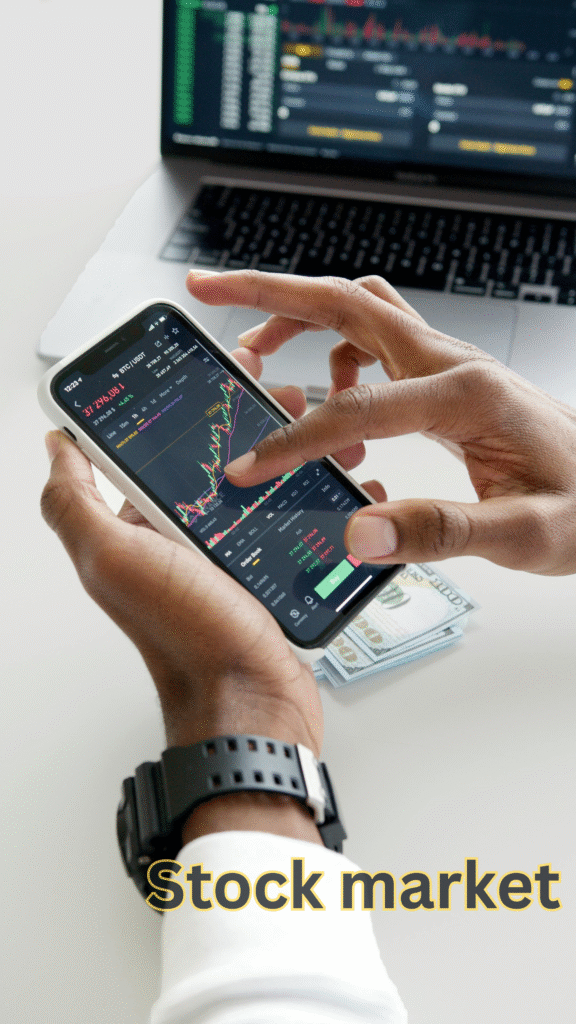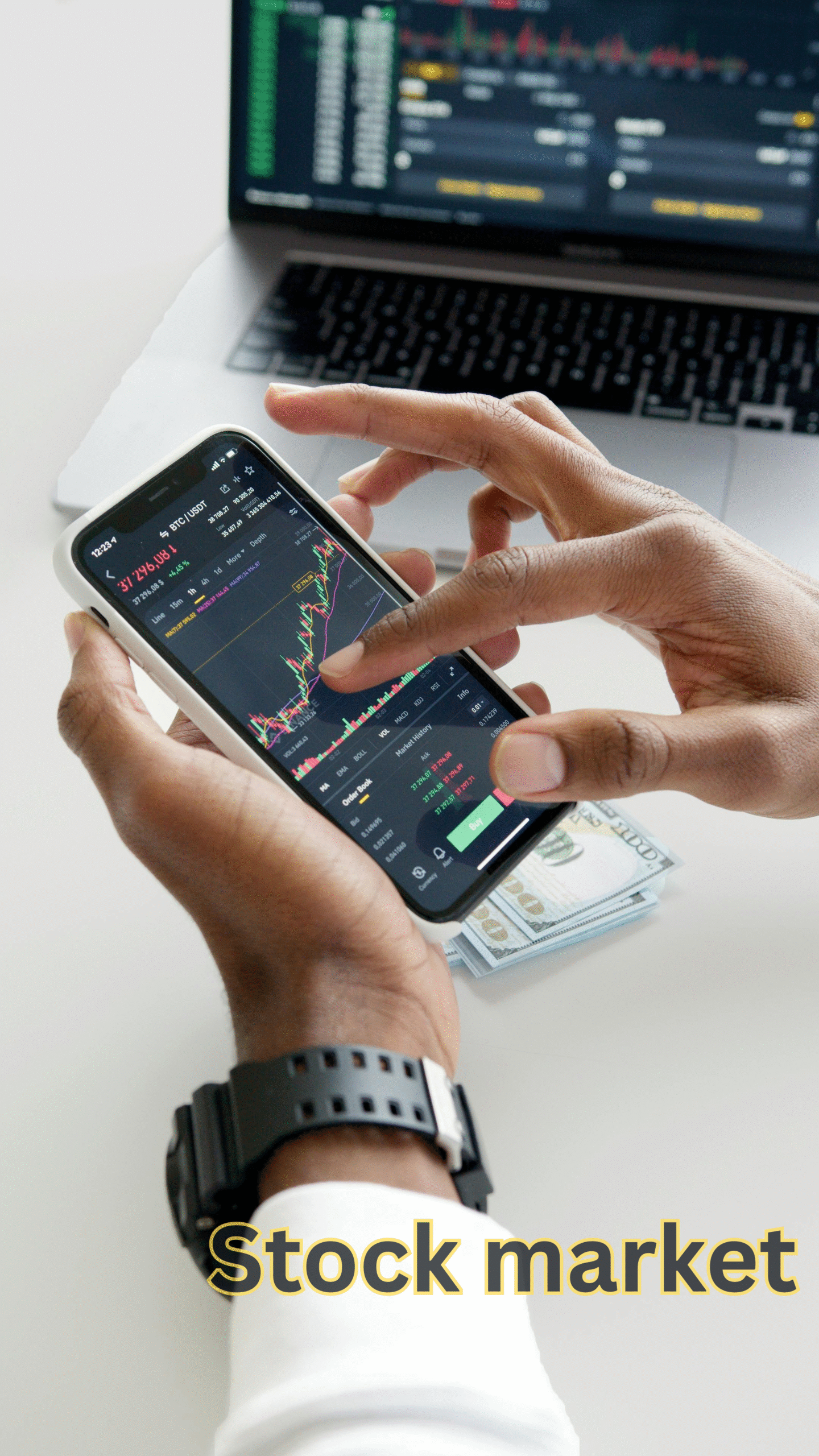The stock market can feel like a thrilling yet intimidating rollercoaster—numbers flashing on screens, terms like “bull” and “bear” buzzing around, and headlines about companies soaring or crashing. For Americans new to investing, it’s an exciting opportunity to grow wealth, whether you’re planning for retirement or aiming for quick profits. In this beginner-friendly guide, we’ll demystify the stock market, explain how it works, explore what drives stock prices, and show you how to get started as a trader or investor. Let’s dive into the action!

What Is the Stock Market?
Picture the stock market as a bustling digital marketplace where people buy and sell shares of publicly traded companies like Apple, Amazon, or Tesla. It’s like an online auction house, but instead of bidding on rare coins or art, you’re trading pieces of businesses. These trades happen electronically through major U.S. stock exchanges, such as the New York Stock Exchange (NYSE) or Nasdaq.
When a company “goes public” through an Initial Public Offering (IPO), it sells shares to raise capital. Once listed, those shares are traded daily on the exchange. The stock market’s primary role is to connect buyers and sellers, ensuring trades happen smoothly and efficiently.
For example, imagine you want to buy shares of Tesla. You place an order through a brokerage like Fidelity, Robinhood, or Charles Schwab. The broker sends your order to the Nasdaq, which matches it with someone selling Tesla shares. Once the trade is complete, you own a small slice of Tesla, and the seller walks away with cash. The process is lightning-fast, but what makes it exciting is the clash of opinions driving each trade.
Why Do People Trade Stocks?
The stock market thrives on differing perspectives. Every trade happens because two parties see a stock’s future differently. Let’s illustrate this with Tesla.
Suppose Tesla’s stock drops from $350 to $300 after news of a production delay at its Gigafactory. Trader A believes the delay will hurt Tesla’s growth and decides to sell. Trader B, however, thinks the market overreacted and expects Tesla to recover once production ramps up. Trader B wants to buy. The stock market brings these two together, letting them trade based on their unique views.
This dynamic—optimism versus pessimism, fear versus greed—keeps the market alive. As a participant, your goal is to form your own perspective, backed by research or news, and act on it. Websites like Yahoo Finance or MarketWatch can help you stay informed about company developments.
What Moves Stock Prices?
Stock prices are like a heartbeat, constantly pulsing up and down based on news, events, and investor sentiment. Understanding these drivers is crucial for navigating the market. Let’s explore this with a hypothetical Tesla scenario.
The Impact of News
It’s 10:00 AM, and Tesla is trading at $300 per share. The company announces a new, affordable electric vehicle model, sparking excitement about future growth. Here’s how the market might react:
| Time | Last Traded Price | Seller’s Asking Price | Buyer’s Action | New Traded Price |
|---|---|---|---|---|
| 10:00 | $300 | $302 | Buys | $302 |
| 10:01 | $302 | $306 | Buys | $306 |
| 10:03 | $306 | $311 | Buys | $311 |
| 10:05 | $311 | $316 | Buys | $316 |
In just five minutes, the stock jumps $16 because buyers are eager to grab shares at higher prices, creating a bullish market. Positive news—like a new product launch or strong earnings—often drives prices up as more people rush to buy.
Now, imagine at 12:30 PM, the U.S. Department of Transportation announces stricter regulations on electric vehicles due to safety concerns. This is bad news for the industry, including Tesla, now trading at $330. Here’s what could happen:
- Impact on Tesla: The stock price might drop as investors worry about higher costs or delays. Despite the earlier positive news, this industry-wide concern could dominate.
- Your Action: Based on this news, you might sell your Tesla shares to avoid potential losses.
- Other EV Stocks: Companies like Rivian, Lucid, or Ford’s electric division could also face selling pressure, as the news affects the entire sector.
Demand and Supply
Stock prices also move based on the balance of demand and supply. If more people want to buy Tesla than sell it, the price rises. If more want to sell, it falls. Blue-chip stocks like Apple or Microsoft see constant trading, so their prices fluctuate even without major news. Smaller companies, like a niche tech startup, might see minimal movement if there’s no buzz or trader interest.
Broader Factors
Beyond company-specific news, stock prices can be influenced by:
- Industry Trends: A boom in artificial intelligence could lift stocks like Nvidia or Intel.
- Economic Events: Federal Reserve rate hikes or inflation reports can sway entire markets.
- Global Sentiment: Trade disputes or geopolitical tensions can shake investor confidence.
For example, when the Federal Reserve cut interest rates in 2023, the U.S. market rallied as investors anticipated economic growth. Such events can move entire sectors or markets, as tracked by indices like the S&P 500.
How to Buy and Sell Stocks
Ready to jump into the stock market? Here’s how it works in the U.S., using Tesla as an example.
- Open a Brokerage Account: Sign up with a broker like Vanguard, E*TRADE, or Interactive Brokers. Link a bank account to fund your trades.
- Place an Order: Log into your brokerage account and place an order to buy 100 Tesla shares at $330 ($33,000 total). Specify the price and quantity.
- Broker Validation: The broker confirms you have enough funds, including any fees, to cover the purchase.
- Exchange Matching: The broker sends your order to the exchange (e.g., Nasdaq), which matches it with a seller (or multiple sellers) offering 100 shares at $330.
- Trade Execution: The trade is executed, and the shares are credited to your brokerage account. The seller’s account is debited.
- Post-Trade: You now own 100 Tesla shares, making you a part-owner of the company (about 0.0000025% based on Tesla’s share count).
The process is seamless, often taking seconds, thanks to modern technology.
What Happens After You Own Shares?
Owning shares isn’t just about watching prices tick up or down. It comes with perks and responsibilities. As a Tesla shareholder, you’re entitled to:
- Dividends: If Tesla pays a dividend (though it currently doesn’t), you’d receive a share of profits. For example, a $1 dividend on 100 shares equals $100.
- Stock Splits: Tesla has split its stock before, potentially increasing your holdings (e.g., a 3-for-1 split turns 100 shares into 300).
- Voting Rights: You can vote on company matters, like board elections, though retail investors rarely sway outcomes.
- Capital Gains: If you sell your shares at a higher price, you earn a profit.
Your shares stay in your brokerage account, and you can sell them anytime during market hours (9:30 AM to 4:00 PM ET, Monday through Friday).
Holding Periods: From Minutes to Forever
How long should you hold a stock? That’s up to you. Some traders hold for minutes, while investors like Warren Buffett aim for “forever.” Using Tesla:
- At 10:00 AM, Tesla jumps from $300 to $316 in five minutes after the new model announcement. A trader might sell at $316, earning $1,600 on 100 shares (a 5.33% return).
- An investor might hold for years, betting on Tesla’s dominance in electric vehicles and clean energy.
Your holding period reflects your strategy—short-term gains or long-term wealth-building.
Calculating Returns: Absolute vs. CAGR
Returns are the name of the game. Here’s how to measure your profits.
Absolute Return
This shows your profit as a percentage. If you buy 100 Tesla shares at $330 ($33,000) and sell at $400 ($40,000), your absolute return is:
[ \text{Absolute Return} = \left( \frac{400}{330} – 1 \right) \times 100 = 21.21% ]
A 21.21% return is impressive, but it doesn’t account for time.
Compounded Annual Growth Rate (CAGR)
CAGR annualizes returns for multi-year investments. If you held Tesla for two years, selling at $400, the CAGR is:
Your investment grew at 10.1% per year, beating high-yield savings accounts (around 4-5% in 2025). For short periods (e.g., six months), annualize the absolute return: 21.21% × 2 = 42.42% per year.
Traders vs. Investors: Which Are You?
Stock market participants fall into two camps: traders and investors. Your choice depends on your risk tolerance, time, and goals.
Traders
Traders chase short-term profits, thriving on market swings. Types include:
- Day Traders: They trade within a day, avoiding overnight risk. Example: Buy 100 Apple shares at $200 at 9:30 AM and sell at $202 by 3:30 PM for a $200 profit.
- Scalpers: They trade huge volumes for tiny gains. Example: Buy 10,000 Apple shares at $200 and sell at $200.05 a minute later for a $500 profit.
- Swing Traders: They hold for days or weeks. Example: Buy Apple at $200 on October 1 and sell at $205 on October 10.
Famous traders like Paul Tudor Jones and Steve Cohen excel at quick, calculated moves.
Investors
Investors focus on long-term growth or value, with longer holding periods. Types include:
- Growth Investors: They target high-growth companies, like Amazon in the 2000s, which skyrocketed as e-commerce took off.
- Value Investors: They buy undervalued stocks, like quality companies during the 2020 COVID crash, which recovered sharply.
Legends like Warren Buffett and Peter Lynch mastered long-term investing. Learn more about their strategies at Investopedia.
Your Style
Are you a thrill-seeker or a patient planner? Traders need time and risk tolerance, while investors need research skills and patience. Many Americans start as investors through 401(k) plans and explore trading later.
Key Tips for American Beginners
- Start Small: Invest a small amount, like $500, to learn without big risks.
- Educate Yourself: Read The Intelligent Investor by Benjamin Graham or follow news on CNBC or Bloomberg.
- Use Robo-Advisors: Platforms like Betterment or Wealthfront automate investing for beginners.
- Diversify: Spread your money across tech, healthcare, and energy stocks to reduce risk.
- Watch Fees: Use low-cost brokers like Vanguard to keep more of your returns.
Conclusion
The stock market is a dynamic arena where news, ideas, and emotions create endless opportunities. Whether you’re trading Tesla for quick profits or investing in Apple for your retirement, understanding price movements, trading processes, and returns is your foundation for success. With U.S. markets offering access to global giants and innovative startups, there’s never been a better time to get involved. So, what’s your next step? Will you buy your first stock or dive deeper into market strategies? The stock market is waiting for you to make your mark!
